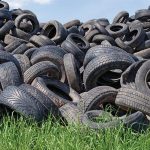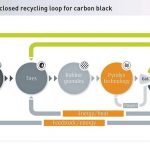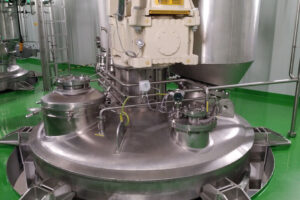In Germany alone, some 630,000 tons of scrap tyres accrue every year – along with 3.2 million tons in the EU as a whole and as much as 4.4 million tons in the USA. Yet what actually happens to them all? Well, since recycling used tyres is not economically viable, end-of-life tyre granules are either incinerated in the cement industry or used in some other way – and plenty of them still end up on landfills all over the world. However, Zeppelin and Pyrolyx have now come up with a closed-loop production system in which scrap tyres can be completely recycled.
Author Rolf-Hendrik Arens Vice President Communications & Investor Relations, Pyrolyx
Disposing of used tyres is no easy matter. In the EU, for example, landfilling waste tyres has long been banned. Nevertheless, around 4 % of scrap tyres in the European Union still end up at a landfill or are illegally dumped. And elsewhere in the world, this problem is far greater. The common practice of using old tyres as fuel makes little sense. Moreover, a constant stream of raw materials – chiefly rubber as well as oil to make synthetic rubber and carbon black (a form of paracrystalline carbon) – is needed to turn them into new tyres. Yet how long will our stocks of carbon, metals and energy last? Using end-of-life tyres as granulate for surfacing or as an additive for asphalt doesn’t reduce the consumption of natural resources. Only genuine recycling – closed-loop systems in which raw materials circulate, are recovered and returned to the loop – can truly cut consumption.
Precious raw materials
A few years ago, Pyrolyx set itself the goal of closing the recycling loop. Apart from boosting the tyre industry’s green credentials, this would also make sound financial sense. After all, every car tyre contains 2 to 3 kg of carbon black – a substance that is used by industry to make dyes, tyres, rubber and synthetic materials, for instance. Global demand for carbon black reached 11 million tons in 2011 – and experts predict that it will grow by 4 % annually. The cost per ton for this ‘industrial soot’ is in the order of 1200 euros depending on its quality and the price of oil – for it takes about 1.7 tons of fossil fuels (oil and gas) to make each ton of carbon black.
Previously, recovering carbon black from the same type of product for which it was intended was not possible – at least, not in a continuous process with a closed recycling loop. Many developers and engineers have already tried in vain to extract this valuable material from end-of-life tyres and then close the recycling loop by using it to manufacture new rubber products. In a pilot plant built in Holland Pyrolyx and its project partner Zeppelin Systems have succeeded in recovering oil, gas and above all high-quality carbon black from used tyres.
Two-stage process
In the Pyrolyx process, granulated tyres can be broken down into raw materials suitable for industrial use, enabling high-quality carbon black to be produced. For this purpose, Pyrolyx technology combines pyrolysis with depolymerisation. In the first recycling stage, the tyres are shredded and the steel and cord they contain separated and recovered as a precondition of achieving rubber granules – the feedstock for the recycling plant. Only standard granules made from old tyres and purchased from established suppliers are used.
The Pyrolyx process entails dissolving organic compounds in the vulcanised rubber granules at temperatures of between 350 and 700 °C in the complete absence of oxygen. The material remains for several hours in the plant, which is divided into zones with different temperatures and processing states. When the gases released there are fed through a condenser, their vaporous organic components liquefy and are then discharged as different oil fractions. The proportions and compositions of these fractions depend on the temperature, the residence time and various other aspects of the process. They can be sold as valuable raw materials, undergo further processing or be used as fuel in the production of additional carbon black. Once they have been freed of their condensable fractions, the gases are comparable to natural gas and can be utilised to generate electricity. The only residue at the outlet is Pyrolyx Carbon Black. It is taken to a cooling zone, where its temperature is brought down to about 50 °C. After flowing into silos and being ground in mills down to a particle size of less than 5 µm, it is packed ready for sale.
Intensive testing
Back in late 2009, a detailed due diligence study was carried out on the Pyrolyx technology by experts from Bayer Technology Services in Leverkusen. They had no hesitation in rating it as commercially sound. They found that all the method’s final products were sustainable materials which met the same standards as traditional carbon black types and could hence be processed very efficiently. A financial analysis indicated that manufacturing Pyrolyx Carbon Black was cheaper than making carbon black by traditional methods, which are extremely dependent on oil prices. And as well as being an ideal filler for use in the rubber and plastics industries, Pyrolyx Carbon Black was revealed to be much kinder to the environment owing to the low emissions during production.
Since 2012, Pyrolyx has been conducting extensive capacity and quality tests at a specially built plant in Drunen in the Netherlands. This pilot plant was designed to allow continuous production of carbon black. In terms of capacity, energy management and output as well as the consistently high quality of the carbon black obtained, the now-completed tests met the company’s high expectations.
The usability and quality of Pyrolyx Carbon Black have also been confirmed in extensive trials by international tyre manufacturers. A series of tests carried out by Continental to see whether Pyrolyx Carbon Black would make a suitable additive for a new generation of tyres went very promisingly according to Niels Raeder, CEO of Pyrolyx AG. The results of these indoor tests are about to be scaled up to a major field trial – and Continental’s comprehensive study will eventually pave the way for volume production of tyres containing Pyrolyx Carbon Black. Zeppelin Systems is meanwhile taking orders for turnkey plants using the Pyrolyx method.
cpp-net.com/0214438
Closed-loop production

Ask the expert
cpp: Mr. Veit, why did Zeppelin Systems decide to get involved in Pyrolyx technology at such an early stage?
Veit: For me personally, it’s self-evident that in no more than ten years, closed-loop production in tyre recycling will be just as natural as it is today for recycling paper and plastics. Initially, there were plenty of reservations regarding the first recycled paper or plastics – but now they’re universally accepted. Zeppelin was already working in the tyre industry. We saw a need to leverage our presence on the market along with our technology and knowledge from tyre production to help develop an ecologically and eco-nomically sustainable loop.
cpp: What part is being played by Zeppelin Systems in planning and building the first commercial plant?
Veit: Zeppelin is the general contractor and we are hence building the entire system – from the raw materials intake to the completion of the saleable product. We are making sure that the system meets the requirements of a modern processing plant and supervising the project until the saleable product has been successfully manufactured.
cpp: What was Zeppelin’s role in the development contributing to the breakthrough of the Pyrolyx process?
Veit: Zeppelin harnessed its expertise in plant engineering to translate the pilot plant technology into a fully fledged industrial process. Afterwards, the scalability of the process and the high quality of the carbon black produced were confirmed on the original scale at the pilot plant in Holland. These successful measures generated the confidence and experience needed to plan the first commercial plant.
Share:











